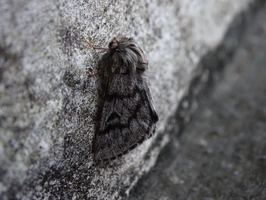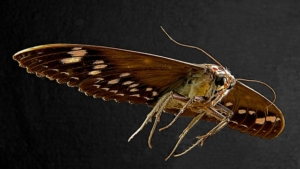The migration flight most commonly starts in mid-May until early June. While the entire migration may last up to six weeks, peak activity typically lasts two to three weeks.
 Insecticides are ineffective in controlling miller moths as they are not vulnerable to a majority of the available products and their mass numbers quickly replace those that have been killed. The best control methods include exclusion by means of sealing gaps and cracks around the home prior to miller moth season. Limiting lighting at night will also aide in the reduction of activity around the home. Altering landscaping may also reduce the number of miller moths by decreasing food sources such as lilac, cherry, spirea, raspberry and Russian olive. Spruce and pines also provide dense, dark hiding locations and may attract additional moths seeking shelter from the daylight.
Insecticides are ineffective in controlling miller moths as they are not vulnerable to a majority of the available products and their mass numbers quickly replace those that have been killed. The best control methods include exclusion by means of sealing gaps and cracks around the home prior to miller moth season. Limiting lighting at night will also aide in the reduction of activity around the home. Altering landscaping may also reduce the number of miller moths by decreasing food sources such as lilac, cherry, spirea, raspberry and Russian olive. Spruce and pines also provide dense, dark hiding locations and may attract additional moths seeking shelter from the daylight.
Most Colorado residents are familiar with the yearly migration resulting in the invasion of the army cutworm miller moths. Although a majority of miller moth activity occurs in eastern Colorado, there is another occurrence of army cutworms along the western slope of the state. Adults have a 1.5-2 inch wide wing span that varies from grey to brown. Markings are also varied and include both light and dark markings. One consistent marking is a kidney-shaped marking on the forewing of miller moths. Adults migrate to the west from eastern Colorado and bordering states including Wyoming, Nebraska, Kansas and Oklahoma in order to have a continuous source of summer flowers that provide the nectar on which adult moths feed. Cooler temperatures at higher elevations are also believed to prolong the adult moths’ lifespan. The migration flight most commonly starts in mid-May until early June. While the entire migration may last up to six weeks, peak activity typically lasts two to three weeks.
 During this time it is not uncommon to find miller moth predators including swallows at street intersections feeding on the abundance of moths as they fly out from under vehicles where they had been hiding. Miller moths avoid daylight, seeking shelter before daylight ever breaks. Ideal hiding locations are dark, tight gaps and cracks in which they can rest until nightfall. As a majority of these gaps and cracks on a home often lead inside, miller moths may enter the home if they go the wrong way when attempting to exit. Miller moths DO NOT reproduce or lay eggs within homes. They also do not feed on home furnishings and will eventually die if they cannot find a way to escape. Large numbers of moths dying within the home may result in an odor due to the fat contained within their bodies. Miller moths may also leave staining on curtains or other surfaces from the spray type fluid that is excreted by adult moths. This fluid is thought to be a defense mechanism. Moths that exit their hideout correctly continue on their migratory paths typically the next night unless weather prevents them from continuing. By the time many of the moths reach the mountains, they will have traveled well over a hundred miles during their migration. Return flights in the fall are less noticeable due to their significantly decreased populations. This reverse migration typically starts in late September and lasts a shorter period of time.
During this time it is not uncommon to find miller moth predators including swallows at street intersections feeding on the abundance of moths as they fly out from under vehicles where they had been hiding. Miller moths avoid daylight, seeking shelter before daylight ever breaks. Ideal hiding locations are dark, tight gaps and cracks in which they can rest until nightfall. As a majority of these gaps and cracks on a home often lead inside, miller moths may enter the home if they go the wrong way when attempting to exit. Miller moths DO NOT reproduce or lay eggs within homes. They also do not feed on home furnishings and will eventually die if they cannot find a way to escape. Large numbers of moths dying within the home may result in an odor due to the fat contained within their bodies. Miller moths may also leave staining on curtains or other surfaces from the spray type fluid that is excreted by adult moths. This fluid is thought to be a defense mechanism. Moths that exit their hideout correctly continue on their migratory paths typically the next night unless weather prevents them from continuing. By the time many of the moths reach the mountains, they will have traveled well over a hundred miles during their migration. Return flights in the fall are less noticeable due to their significantly decreased populations. This reverse migration typically starts in late September and lasts a shorter period of time.
Upon returning to the plains areas where they originally hatched, miller moths begin the process of laying eggs for the next generation. Eggs are laid in late summer to early fall in weeded areas of crop fields and turf grass where vegetation is thick. The eggs will hatch a few weeks later and the army cutworm caterpillars begin to feed. Their food supply includes a wide range of broadleaf plants and grasses. Army cutworms over winter as caterpillars and continue feeding on plants as the weather permits. Early spring is the primary time in which army cutworms damage crops, garden plants and lawns. High populations can result in the consumption of entire plants during this time and may also result in the caterpillars banding together in an “army” as they cross fields and highways. As early as March, full grown caterpillars begin their pupation by burrowing into the soil. This process can occur as late as May. Three to six weeks later, adults emerge to begin the cycle again.